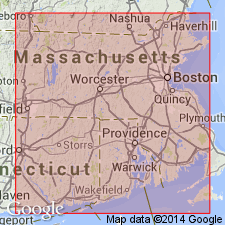
- Usage in publication:
-
- Beavertail Point Member
- Modifications:
-
- Principal reference
- Dominant lithology:
-
- Phyllite
- Siltstone
- AAPG geologic province:
-
- New England province
Summary:
Pg. 33-35; see also Skehan and others, 1981, NEIGC 73rd Ann. Mtg., Trip C-1, p. 237-264. Beavertail Point Member of Jamestown Formation of Conanicut Group (new). Consists of 80 to 90 percent green phyllite, 10 to 15 percent buff and white, brown- to orange-weathering siltstone, and 5 percent black phyllite. [Thickness not stated.] Lies below Short Point Member of Fort Burnside Formation of Conanicut Group. [Not in stratigraphic contact with other members of the Jamestown. Shown on fig. 8 (p. 33) above Lion Head Member and correlative with Hull Cove Member; upper part correlative with Bass Rock Member (new).] Contains worm trail ichnofossils PALAEOPHYCUS (=BUTHROTREPHIS), PLANOLITES, and HELMINTHOPSIS (Skehan and others, GSA-NE Section Cent. Field Guide, v. 5, p. 200). Age is Middle Cambrian.
Type locality: along southeastern shore of Beavertail Point, near the Beavertaill Point lighthouse, southern end western Conanicut Island, Narragansett Bay, [Narragansett Pier 7.5-min quadrangle, Newton Co.], southeastern RI.
Source: Publication.
For more information, please contact Nancy Stamm, Geologic Names Committee Secretary.
Asterisk (*) indicates published by U.S. Geological Survey authors.
"No current usage" (†) implies that a name has been abandoned or has fallen into disuse. Former usage and, if known, replacement name given in parentheses ( ).
Slash (/) indicates name conflicts with nomenclatural guidelines (CSN, 1933; ACSN, 1961, 1970; NACSN, 1983, 2005, 2021). May be explained within brackets ([ ]).

